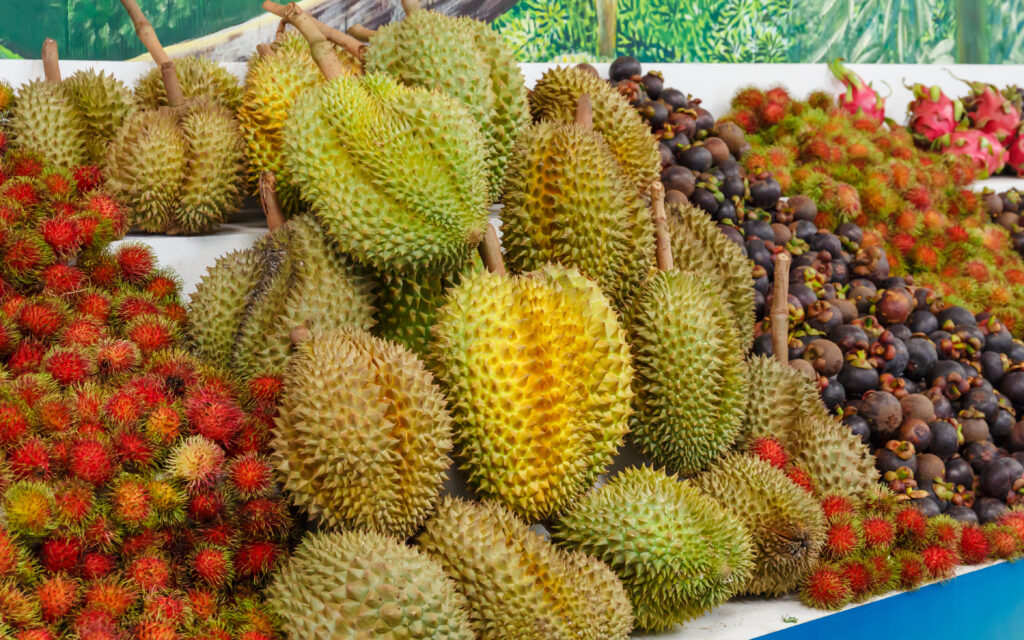There’s more to the world of fruits than just apples and oranges, and some tropical and lesser-known varieties are deliciously exotic and packed full of vitamins and soluble fiber. If you’re getting bored with the local grocery store fruit aisle, why not try something new and adventurous instead? Here are 12 fruits you’ve probably never heard of but are worth trying. You never know; one of these could become your new favorite breakfast accompaniment or latest smoothie ingredient.

Rambutan
This spiky red fruit from Southeast Asia is visually striking with its hairy exterior. Underneath the spiky red shell lies a translucent, white flesh with a slightly sweet and tangy taste. The texture is similar to grapes, with a single, large seed in the center. Rambutan is a good source of vitamin C and antioxidants, and it can be enjoyed fresh, canned, or even dried.
Mangosteen
Often referred to as the “Queen of Fruits,” the mangosteen hails from Southeast Asia and boasts a thick, purple rind that can be quite difficult to crack open. Inside, you’ll find juicy, white segments with a sweet and slightly tangy flavor reminiscent of peaches and citrus fruits. The mangosteen is not only delicious but also boasts anti-inflammatory and antioxidant properties.
Cherimoya
Native to the Andes mountains, this heart-shaped fruit has a green, scaly skin and creamy white flesh. The flavor is often described as a delightful mix of banana, pineapple, and papaya, with a smooth texture and a custard-like consistency. Cherimoya is a good source of vitamin C and fiber, and it can be enjoyed fresh, used in smoothies, or made into a delicious and refreshing ice cream. Perfect for a hot day!
Jabuticaba
This unique Brazilian fruit grows directly on the trunk and branches of the tree, creating a visually stunning effect that has to be seen to be believed. The deep purple skin encloses a white, gelatinous flesh with a sweet and slightly tart flavor. Like other fruits on this list, it’s a good source of antioxidants and vitamin C, and although it can be eaten fresh, it’s commonly made into jams and jellies or even fermented into wine.
Cupuacu
Capuacu comes from the Amazon rainforest and is related to cocoa, with a thick, brown rind enclosing a white, pulpy flesh. The flavor is slightly acidic but is said to taste something like melon-infused cocoa or chocolate! Cupuacu is a good source of vitamin C and contains plenty of unsaturated ‘healthy’ fats. It is very nutritious and can be eaten fresh, made into juice, or used in desserts and ice cream.
Kiwano
Also known as the horned melon, this African fruit has a bright orange, spiky rind with a green, jelly-like flesh. The flavor is surprisingly refreshing, apparently similar to a mix of cucumber, banana, and lime. Kiwano is a good source of vitamin C and potassium, so it’s great for concentration and brain power. You can eat it fresh, in salads, or even make it into a sweet and tangy salsa.
Yacón
This South American tuberous root vegetable has a sweet and slightly nutty flavor and is often enjoyed raw or roasted. It’s a good source of prebiotics, which are beneficial for gut health, and can be a delicious substitute for potatoes or other starchy vegetables. Yacón can also be juiced or made into a naturally sweet syrup.
Physalis
Also known as cape gooseberries, these small, bright-orange and somewhat golden fruits have a papery husk that encloses a sweet and tangy berry. They can be enjoyed fresh or used in jams, desserts, and cocktails. Physalis are a good source of vitamin C and antioxidants, and they add a unique flavor and texture to various dishes, including desserts and exotic salads.
Durian
Nicknamed the “King of Fruits” in Southeast Asia, durian is notorious for its pungent aroma, often described as a mix of onions, cheese, and burnt caramel! This strong smell can be off-putting for some, but those who can brave it are rewarded with a creamy, custard-like flesh boasting a sweet and savory flavor. The large, spiky fruit can weigh up to 12 pounds and contains several large seeds. Despite its intense odor, durian is a popular delicacy in Southeast Asia and is often enjoyed fresh, incorporated into desserts, or used to flavor savory dishes.
Feijoa
This oval-shaped fruit from South America has a green skin with a creamy white flesh speckled with black seeds. The flavor is a unique blend of pineapple, guava, and banana, with a slightly floral aroma. It’s also a good source of vitamin C and fiber. Try adding it to smoothies for extra flavor and nutrition, juice it or cut it up and eat it fresh.
Duku
Duku is related to the rambutan and also comes from Southeast Asia. It has a hairy, brown rind with white, translucent flesh. The flavor is sweet and slightly tangy, with a pleasant, jelly-like texture that makes it especially easy and clean to eat on-the-go. Duku can be enjoyed fresh or used in salads and desserts, and is a good source of vitamin C and antioxidants.
Atemoya
This spiny, green fruit is a hybrid of the cherimoya and the custard apple. The flesh is creamy white with a sweet and slightly tangy flavor, often described as a tropical blend of pineapple, banana, and mango. Atemoya is a good source of vitamin C and soluble fiber, so it’s great for keeping you ‘regular.’ You can eat it fresh, make it into juice, or use it in ice cream and smoothies.






